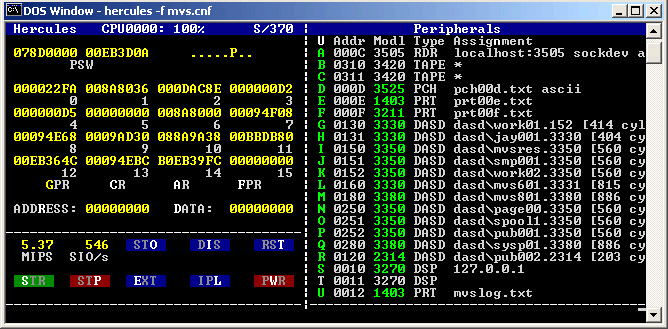

When Hercules begins executing, what appears in the console window where Hercules is executing is the text-mode display. Unless you have a specific need to see the detailed information that is available in this display, which is more like a trace of Hercules' input/output activity, the semi-graphical version of the Hercules console is much more useful. The console shown above is the semi-graphical display from version 3.01 of Hercules, operating under the CYGWIN environment on a Windows/2000 microcomputer. To toggle between the two displays, use the Escape key. The screen is divided into two parts.
The left portion of the screen provides the type of information that would typically be available from the CPU control panel. The top line shows the current Program Status Word and the operating status. Beneath this line are the contents of the sixteen general purpose registers. One of the more interesting pieces of information on this portion of the display is the computed processing rate, shown in Millions of Instructions per Second near the lower left. To the right of the MIPS rate, the computed Started I/O operations per Second is displayed.
The right portion of the screen is a columnar display showing information about the first twenty-one emulated hardware devices:
The first column contains a letter (ranging from A to U) and provides the means to reference a device when issuing commands to alter the operational characteristics of the device.
The second column displays the channel and unit address by which the device is known to software running on the emulated 370/390 hardware.
The third column lists the type of device - RDR (card reader), PCH (card punch), PRT (line printer), DSP (3270 display), DASD (disk storage), or TAPE (tape drive).
The fourth column lists device specific characteristics for each device. The most frequently used of these characteristics is the host operating system file that is being used as the source/target of input/output by Hercules' to emulate the 370/390 hardware device.
Which devices are emulated by Hercules, and their characteristics, is determined by the contents of the Hercules' configuration file (read by Hercules when it is initially executed). Devices may also be attached or detached, or their characteristics altered, by using Hercules' commands.
For instructions on commands available to Hercules, visit the Hercules home site at: http://www.hercules-390.eu/
This page was last updated on January 16, 2015.